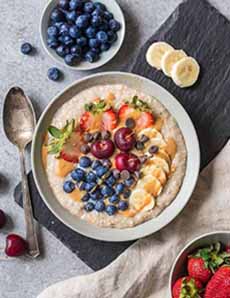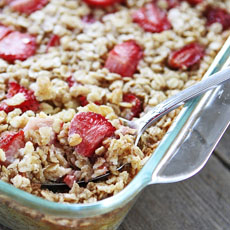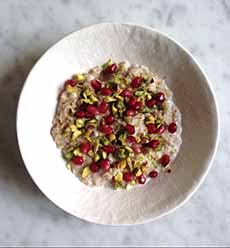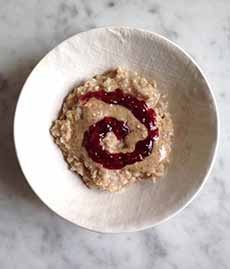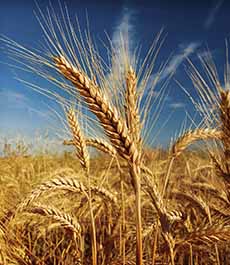The Different Types Of Oatmeal For National Oatmeal Month
|
January is National Oatmeal Month, a whole-grain cooked breakfast cereal that’s an excellent source of niacin, riboflavin, and iron, and helps to bolster energy levels. Athletes and diabetics eat oatmeal for its high content of complex carbohydrates and fiber, which abet slow digestion and stable blood glucose levels. Oats are the grain, and oatmeal is the porridge made of coarsely ground, unsifted oats. In case you read through all of those childhood fairy tales without a true understanding of the word, porridge is a soft food made of oats, or other cereals, boiled to a thick consistency in water or milk. Optional flavorings can be added, from spices to fruits or cheese. Porridge is usually served hot for breakfast, in a bowl or dish. It may be sweetened with sugar or served as a savory dish (cheese grits is an example). Any cereal grain can be turned into porridge. Buckwheat, oats, wheat (Cream of Wheat, Wheatena), and rice (Cream of Rice) are most popular in the U.S. Worldwide, barley, fonio, maize, millet, rice, rye, sorghum, triticale, and quinoa are also made into porridge. Gruel, a word well-known to those readers of Charles Dickens’ Oliver Twist, is a thin, watery porridge fed to those not affluent or deserving enough for the good stuff. Early in the English language, “porridge” referred to a soup of meat and vegetables, from the Middle English porreie (which derived from Old French poree, leek soup, via the Latin porrum, leek). Check out the different types of oats below. But first: Oats are an ancient grain with a long history of sustenance. Hunter-gatherers ate wild oats as far back as 32,000 years ago—long before farming began, which was some 12,000 years ago. It was one of the first cereals cultivated by man. Evidence of oat cultivation in China dates far back as 7,000 B.C.E. The ancient Greeks are believed to be the first to make porridge from oats. The Romans followed the Greeks in cultivating oats and introduced them to other countries as they conquered Western Europe. They named oats and other crops “cereals” after Ceres, the Roman goddess of agriculture. The first record we have that associates porridge with oatmeal is a Scottish reference from 1643. Scotland was a big oat-growing country—the climate favors oats over corn and wheat. In Scotland, Ireland, and elsewhere, most households held stores of oats to use for bread, porridge, and as a key ingredient for making black pudding (blood pudding)*, a type of blood sausage. Up until the 1800s, milled oats were a coarser grain than the oats we know today. The Industrial Revolution enabled machine milling, which produced finer oats. In the 19th and 20th centuries, porridge became a more popular breakfast dish. Oatmeal for breakfast was promoted by the oatmeal producers like Flahavan’s. Since then, oatmeal has become a favorite breakfast food in the United Kingdom and the United States, although only one in five Americans eat it, according to the NPD Group, an independent research firm. Tastes change over time and porridge is now mostly made with the finer-milled oat flakes we all have in our kitchen cupboards [source]. All generations should be eating more of it—for its whole-grain fiber and heart-healthy ability to reduce cholesterol. Kids should eat it instead of less-nutritious breakfast cereals or childhood-obesity-inducing breakfast pastries. Oatmeal, warm and comforting, can be dressed up in so many ways, both savory and sweet. After harvest, the hull (husk) is removed from the oats and the groats (kernels) are toasted to stabilize enzymes that cause rancidity. Then, they are variously coarsely ground into meal (crushed oats), steamed and rolled on steel or stone rollers to make rolled oats, or cut into small pieces to make steel-cut oats. While whole oat groats can be purchased, and are more nutritious because they are minimally processed, they require a long time to cook and are very chewy—not the soft food that we know as oatmeal. The longer you cook oats, the more texture, and flavor they have. The longest-cooking are steel-cut oats, then rolled oats, then quick oats, then instant oats. Crushed Oats Crushed oats are groats that are lightly ground in a hammer mill, creating a meal-type product. It’s unusual to find them in U.S. markets. Boiling crushed oats creates a porridge with a farina texture. Uncooked, crushed oats are also a favorite food of the equine and bovine populations (only 5% of the oats grown in the world are consumed by humans). Crushed oats are also used in oatmeal-based health and beauty aids. Rolled Oats Rolled oats are what most Americans think of as oatmeal. Quaker Oats’ standard product is called Old Fashioned Oats, a term used by other companies as well for their standard rolled oat products. Standard rolled oats are also known as flaked oats and oat flakes: the groats are steamed and then rolled and flaked. The calibration of the rollers produces a spectrum of products, including instant oats, quick oats, rolled oats/old-fashioned oats, and thick-rolled oats. The thinner the oats are rolled (i.e., the thinner the flake), the more surface area, and the quicker they cook because of the greater surface area of the grain. Rolled oats cook for five minutes. Instant Oats If you don’t have time or the facility to cook, instant oatmeal is made from oats that are rolled very thin and precooked, then dehydrated. They are generally packaged in single-serve packets and need only be mixed with a hot liquid to plump up into oatmeal. While you can’t beat the convenience, they lack the texture and flavor of cooked oats (although the nutrition is about the same, and some brands like Quaker enrich their product with extra vitamins and/or calcium). We like keeping boxes of these in our desk drawer at work, for a healthier breakfast than a bagel or other workplace option, and a nutritious snack any time of the day or night. They cook “instantly” when boiled water or milk is added; or can be cooked in the microwave with cold water for 90 seconds. Overnight Oats Overnight oats are a way of preparing oatmeal by soaking the oats overnight, instead of cooking them. Raw oats are soaked in your choice of liquid: drinkable yogurt or kefir, milk or nondairy milk (almond milk is splendid), water, yogurt/water mix, or whatever. The soaking turns oatmeal into a cold breakfast cereal, although you can certainly heat it. Here’s a recipe (photo #7). Quick Oats Quick oats are rolled oats that are thicker and thus chewier than instant oats, but not as thick as regular rolled oats. They cook in one minute. Steel-Cut Oats Oatmeal imported from Ireland and Scotland tends to be steel-cut oats. Steel-cut oats are also called cut oats, Irish or Scottish Oats, and coarse-cut oats. The groats have been cut into very small pieces, not rolled into flakes. Cooking time is considerably longer than for rolled oats—30 minutes—but the cooked oatmeal has a nice texture to it—it’s more al dente than rolled oats. While they take considerably longer than rolled oats to make, they deliver a firmer texture (it’s a great texture) and a slightly nutty taste. A unique milling process cooks the oats twice, then carefully rolls them to retain their distinctive texture and creamy taste. |
|
|
|
CHECK OUT WHAT’S HAPPENING ON OUR HOME PAGE, THENIBBLE.COM.
|
||

